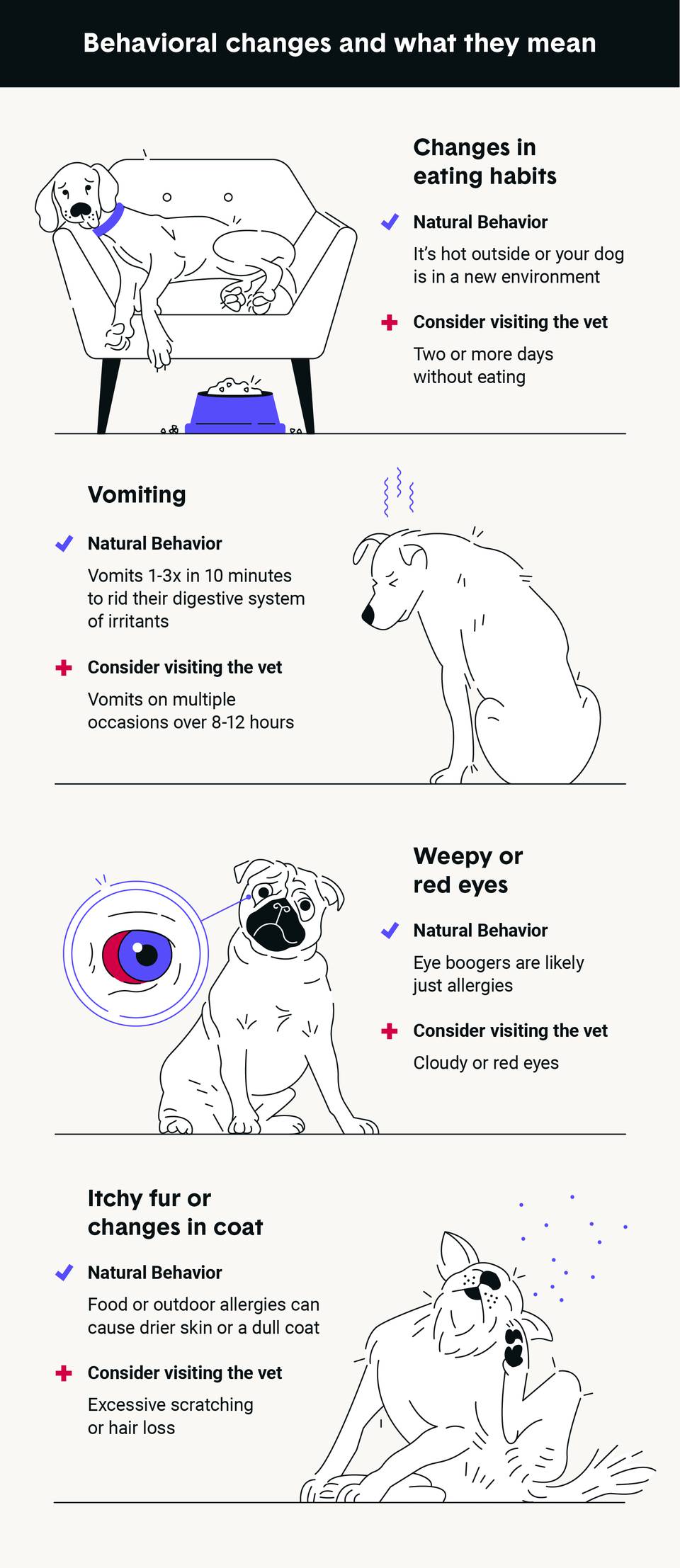1. Changes in eating habits
It’s pretty unusual for dogs to skip a meal unless it’s hot outside or he or she is in a new environment. If your dog goes two days without eating, you should contact your veterinarian.
On the other hand, if your dog is begging for food excessively or is unusually hungry, this could be a medical issue. Consider scheduling an appointment with your veterinarian.
Pet owner tip: When changing dog foods or brands, slowly introduce the new food by offering your pup a mix of 25% new food and 75% old food the first two days, then a 50/50 mix the next two days.
2. Vomiting
Like humans, dogs vomit to rid their digestive system of whatever is causing the issue. Normally, dogs will vomit one to three times in 10 minutes. However, if your dog is vomiting multiple times throughout the day it can cause dehydration and you should contact your veterinarian.
Pet owner tip: Chocolate, coffee, grapes and garlic are toxic to dogs. View our list of safe and unsafe foods for dogs.
3. Changes in stool
A dog’s stool should be firm and moist. If the stool is hard and dry or your dog has difficulty defecating, a dietary issue or illness could be to blame. If you notice worms, mucus, blood or diarrhea for more than 24 hours it’s worth contacting your veterinarian.
Pet owner tip: If your dog is constipated or has diarrhea, pumpkin is a safe and healthy dietary fix. You can use pure canned pumpkin or put pumpkin powder in their food.
4. Poor balance
If you notice changes in your dog’s movement, gait or balance you should make an appointment with a veterinarian right away. A limp can indicate a strained tendon, but balance issues or awkward motions can point to neurological concerns.
Pet owner tip: Before calling your veterinarian, write down how your dog’s movement has changed and approximately for how long it’s occurred.
5. Fur changes or itchiness
Dry skin or a dull coat can result from food or outdoor allergies. However, excessive scratching or hair loss can mean that thyroid issues or fleas are present. It’s best to call your vet just in case.
Pet owner tip: You can supplement your dog’s food with a teaspoon of coconut oil or Omega-3 and Omega-6 acids once or twice a day to improve your dog’s skin and coat.
6. Weepy or red eyes
If your dog develops eye boogers it’s likely just seasonal allergies. However, red and cloudy eyes or unusual eye discharge can indicate infection or injury. Note that if only one eye seems to be bothersome it’s more likely an injury or infection. If both eyes are problematic, it could be a systemic issue. Either way, contact your veterinarian.
Pet owner tip: If your dog is prone to allergies, avoid walking them early in the morning or late in the afternoon when pollen levels are usually highest.
7. Lethargic behavior
If your dog is unusually disinterested in going on walks or playing or less responsive to commands, he or she might be ill. If symptoms persist for more than two days, schedule an appointment with your vet.
Pet owner tip: Dogs older than 10 months sleep an average of 10-12 hours per day due to being in rapid eye movement (REM) or deep sleep only 10% of the time. Puppies typically need 18-20 hours each day.
8. Wincing, crying or whining
Whining or wincing is a sign that your dog is in distress. If there’s no apparent environmental or medical reason for this behavior, your dog could be experiencing some sort of internal pain and discomfort. It’s best to schedule a visit to the vet and to expect a diagnostic tool such as an ultrasound, MRI or X-ray to be used.
Pet owner tip: Some dogs will whine as an appeasement or greeting behavior when interacting with people or other dogs. If the whining seems involuntary, it could be due to stress and anxiety.






